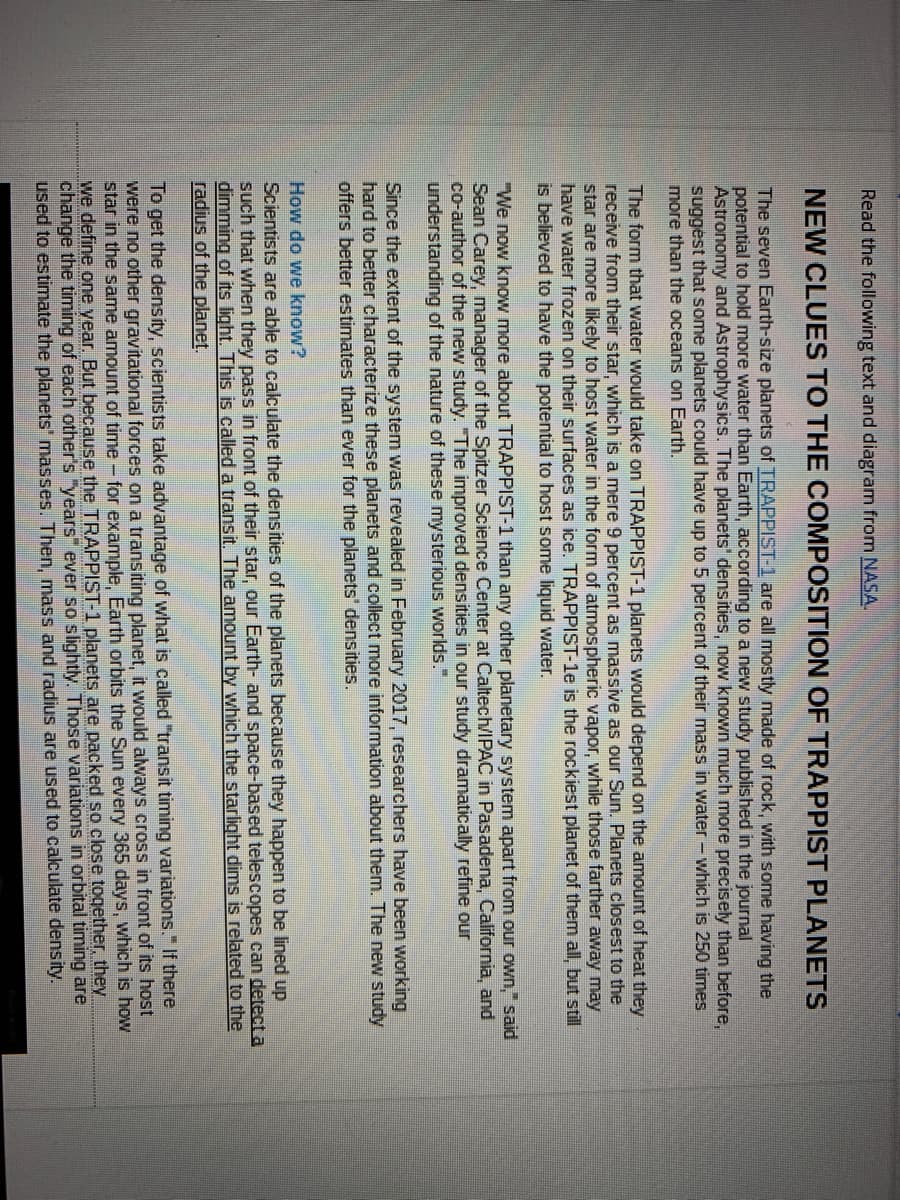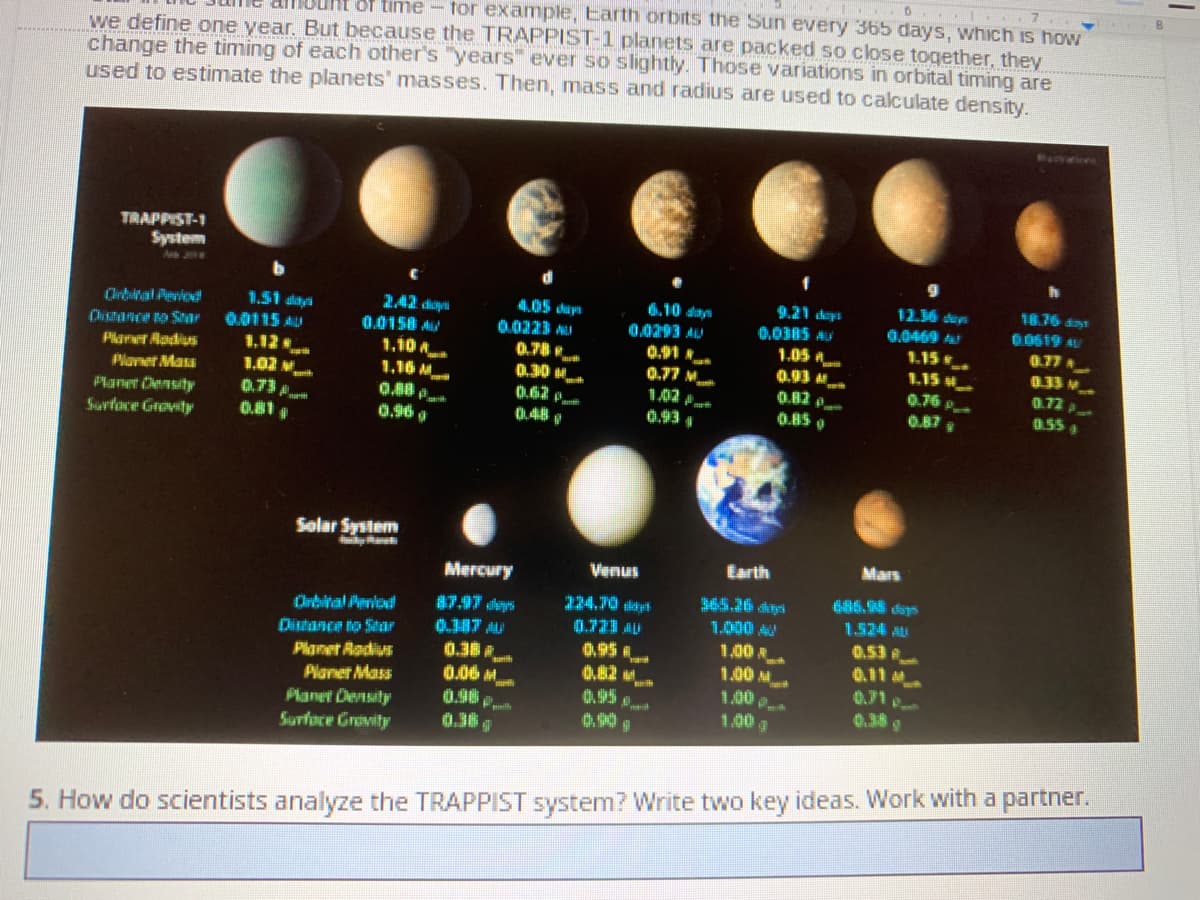the following text and diagram from NASA. CLUES TO THE COMPOSITION OF TRAPPIST PLANETS ven Earth-size planets of TRAPPIST-1 are all mostly made of rock, with some having the al to hold more water than Earth, according to a new study published in the journal omy and Astrophysics. The planets' densities, now known much more precisely than before, st that some planets could have up to 5 percent of their mass in water - which is 250 times man the oceans on Earth. m that water would take on TRAPPIST-1 planets would depend on the amount of heat they - from their star, which is a mere 9 percent as massive as our Sun. Planets closest to the e more likely to host water in the form of atmospheric vapor, while those farther away may ater frozen on their surfaces as ice. TRAPPIST-1e is the rockiest planet of them all, but still ved to have the potential to host some liquid water. w know more about TRAPPIST-1 than any other planetary system apart from our own," said arey, manager of the Spitzer Science Center at Caltech/IPAC in Pasadena, California, and or of the new study. "The improved densities in our study dramatically refine our canding of the nature of these mysterious worlds." he extent of the system was revealed in February 2017, researchers have been working better characterize these planets and collect more information about them. The new study etter estimates than ever for the planets' densities. we know? =ts are able to calculate the densities of the planets because they happen to be lined up at when they pass in front of their star, our Earth- and space-based telescopes can detect a of its light. This is called a transit. The amount by which the starlight dims is related to the of the planet. he density, scientists take advantage of what is called "transit timing variations." If there other gravitational forces on a transiting planet, it would always cross in front of its host the same amount of time - for example, Earth orbits the Sun every 365 days, which is how PIST-1 planets are packed so close together, they
the following text and diagram from NASA. CLUES TO THE COMPOSITION OF TRAPPIST PLANETS ven Earth-size planets of TRAPPIST-1 are all mostly made of rock, with some having the al to hold more water than Earth, according to a new study published in the journal omy and Astrophysics. The planets' densities, now known much more precisely than before, st that some planets could have up to 5 percent of their mass in water - which is 250 times man the oceans on Earth. m that water would take on TRAPPIST-1 planets would depend on the amount of heat they - from their star, which is a mere 9 percent as massive as our Sun. Planets closest to the e more likely to host water in the form of atmospheric vapor, while those farther away may ater frozen on their surfaces as ice. TRAPPIST-1e is the rockiest planet of them all, but still ved to have the potential to host some liquid water. w know more about TRAPPIST-1 than any other planetary system apart from our own," said arey, manager of the Spitzer Science Center at Caltech/IPAC in Pasadena, California, and or of the new study. "The improved densities in our study dramatically refine our canding of the nature of these mysterious worlds." he extent of the system was revealed in February 2017, researchers have been working better characterize these planets and collect more information about them. The new study etter estimates than ever for the planets' densities. we know? =ts are able to calculate the densities of the planets because they happen to be lined up at when they pass in front of their star, our Earth- and space-based telescopes can detect a of its light. This is called a transit. The amount by which the starlight dims is related to the of the planet. he density, scientists take advantage of what is called "transit timing variations." If there other gravitational forces on a transiting planet, it would always cross in front of its host the same amount of time - for example, Earth orbits the Sun every 365 days, which is how PIST-1 planets are packed so close together, they
Applications and Investigations in Earth Science (9th Edition)
9th Edition
ISBN:9780134746241
Author:Edward J. Tarbuck, Frederick K. Lutgens, Dennis G. Tasa
Publisher:Edward J. Tarbuck, Frederick K. Lutgens, Dennis G. Tasa
Chapter1: The Study Of Minerals
Section: Chapter Questions
Problem 1LR
Related questions
Question
Do question 5

Transcribed Image Text:Read the following text and diagram from NASA.
NEW CLUES TO THE COMPOSITION OF TRAPPIST PLANETS
The seven Earth-size planets of TRAPPIST-1 are all mnostly made of rock, with some having the
potential to hold more water than Earth, according to a new study published in the journal
Astronomy and Astrophysics. The planets' densities, now known much more precisely than before,
suggest that some planets could have up to 5 percent of their mass in water - which is 250 times
more than the oceans on Earth.
The form that water would take on TRAPPIST-1 planets would depend on the amount of heat they
receive from their star, which is a mere 9 percent as massive as our Sun. Planets closest to the
star are more likely to host water in the form of atmospheric vapor, while those farther away may
have water frozen on their surfaces as ice. TRAPPIST-1e is the rockiest planet of them all, but still
is believed to have the potential to host some liquid water.
"We now know more about TRAPPIST-1 than any other planetary system apart from our own, said
Sean Carey, manager of the Spitzer Science Center at Caltech/IPAC in Pasadena, California, and
co-author of the new study. "The improved densities in our study dramatically refine our
understanding of the nature of these mysterious worlds."
Since the extent of the system was revealed in February 2017, researchers have been working
hard to better characterize these planets and collect more information about them. The new study
offers better estimates than ever for the planets' densities.
How do we know?
Scientists are able to calculate the densities of the planets because they happen to be lined up
such that when they pass in front of their star, our Earth- and space-based telescopes can detect a
dimming of its light. This is called a transit. The amount by which the starlight dims is related to the
radius of the planet.
To get the density, scientists take advantage of what is called "transit timing variations." If there
were no other gravitational forces on a transiting planet, it would always cross in front of its host
star in the same amount of time - for example, Earth orbits the Sun every 365 days, which is how
we define one year. But because the TRAPPIST-1 planets are packed so close together, they
change the timing of each other's "years" ever so slightly. Those variations in orbital timing are
used to estimate the planets' masses. Then, mass and radius are used to calculate density.

Transcribed Image Text:of time – tor example, Earth orbits the Sun every 365 days, which is how
we define one year. But because the TRAPPIST-1 planets are packed so close together, they
change the timing of each other's "yearS" ever so slightly. Those variations in orbital timing are
used to estimate the planets' masses. Then, mass and radius are used to calculate density.
TRAPPIST-1
System
12.36 dun
18.76 ayt
4.05 dayn
6.10 dayn
9.21 deạt
242 deya
0.0158 A
1,10 A
1,16 M
0.0619 AU
0.77
0.33
0.72p
1.51 dayi
0.0469
0.0293 AU
0.91
0.77 M
0.0385 A
1.05 a
0.93 .
0.0223
0.0115 AU
1.15
0.78
Plarut Nødius
1,12
1.15
0.30
0.76 P
0.87
Plavner Mass
1.02
0.55 g
0.85
Planet Cersity
Surface Grovity
.48
0.93
0.96 g
Solar System
Earth
Mars
Venus
Mercury
685.98 dps
非7,特7 dhs
0.38岁 A
224.70 layt
0.723 AU
部点,26 cays
1.000 AV
Orbiral Period
1.524 AU
Distance to StAF
Planet Apdius
Planet MMass
0.53
0.11 M.
0.31 P
0.38 g
0.95 .
小收2 an,
1.00 R
1.00 AM
0.38
0.06 M
0.98
n th
1.00
1.,00 g
Planet Density
Surface Gravity
0.36 g
小,0
5. How do scientists analyze the TRAPPIST system? Write two key ideas. Work with a partner.
Expert Solution
This question has been solved!
Explore an expertly crafted, step-by-step solution for a thorough understanding of key concepts.
Step by step
Solved in 3 steps

Recommended textbooks for you

Applications and Investigations in Earth Science …
Earth Science
ISBN:
9780134746241
Author:
Edward J. Tarbuck, Frederick K. Lutgens, Dennis G. Tasa
Publisher:
PEARSON

Exercises for Weather & Climate (9th Edition)
Earth Science
ISBN:
9780134041360
Author:
Greg Carbone
Publisher:
PEARSON

Environmental Science
Earth Science
ISBN:
9781260153125
Author:
William P Cunningham Prof., Mary Ann Cunningham Professor
Publisher:
McGraw-Hill Education

Applications and Investigations in Earth Science …
Earth Science
ISBN:
9780134746241
Author:
Edward J. Tarbuck, Frederick K. Lutgens, Dennis G. Tasa
Publisher:
PEARSON

Exercises for Weather & Climate (9th Edition)
Earth Science
ISBN:
9780134041360
Author:
Greg Carbone
Publisher:
PEARSON

Environmental Science
Earth Science
ISBN:
9781260153125
Author:
William P Cunningham Prof., Mary Ann Cunningham Professor
Publisher:
McGraw-Hill Education

Earth Science (15th Edition)
Earth Science
ISBN:
9780134543536
Author:
Edward J. Tarbuck, Frederick K. Lutgens, Dennis G. Tasa
Publisher:
PEARSON

Environmental Science (MindTap Course List)
Earth Science
ISBN:
9781337569613
Author:
G. Tyler Miller, Scott Spoolman
Publisher:
Cengage Learning

Physical Geology
Earth Science
ISBN:
9781259916823
Author:
Plummer, Charles C., CARLSON, Diane H., Hammersley, Lisa
Publisher:
Mcgraw-hill Education,